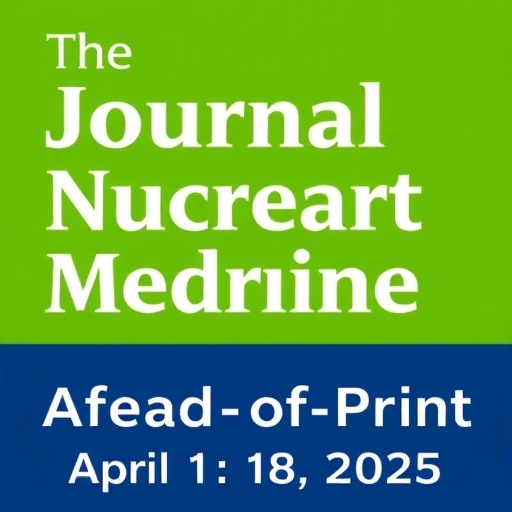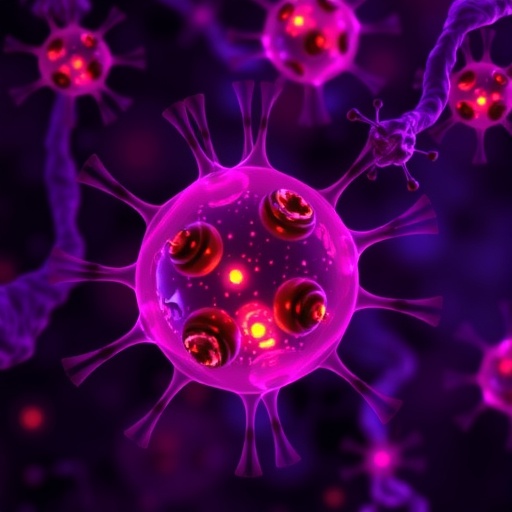
Reston, VA (April 18, 2025)—In a series of breakthrough developments, The Journal of Nuclear Medicine (JNM) has unveiled pioneering research that promises to revolutionize diagnostic imaging and precision medicine in oncology and neurology. These newly published studies leverage cutting-edge molecular imaging technologies to enhance the detection, differentiation, and prognosis of complex diseases, representing significant strides toward more personalized and effective patient care. The insights elucidated across multiple investigations showcase the transformative potential of positron emission tomography (PET) combined with novel radiotracers and advanced scanning systems, redefining the capabilities of nuclear medicine in clinical practice.
One of the most compelling advances reported involves the creation of an innovative imaging agent specifically engineered to target triple-negative breast cancer (TNBC), a notoriously heterogeneous and aggressive subtype characterized by the absence of estrogen, progesterone, and HER2 receptors. This novel agent binds to a shared protein expressed across various TNBC phenotypes, enabling comprehensive visualization of this elusive tumor type. Preclinical models utilizing PET/CT scanning demonstrated the agent’s capacity to accurately highlight tumors with diverse molecular profiles, offering unprecedented precision in detecting and characterizing TNBC lesions. Such improvements are critical given the difficulty in diagnosing and treating TNBC, which lacks targeted therapies and is often associated with poor patient outcomes.
In the realm of neurodegenerative disease, a cutting-edge brain imaging technique utilizing the radiotracer ^18F-florzolotau showed promising results for differentiating atypical parkinsonian syndromes, including progressive supranuclear palsy (PSP) and corticobasal degeneration (CBD). Both disorders often present with overlapping clinical features, complicating diagnosis and delaying appropriate intervention. The study demonstrated that specific visual patterns identifiable on ^18F-florzolotau PET scans allowed clinicians to more effectively distinguish these disorders from other neurodegenerative conditions in real-world settings. This advancement not only enhances diagnostic accuracy but also underscores the growing role of tau-targeted PET imaging in clarifying complex neuropathologies.
Another noteworthy contribution centers on the prognostic capabilities of early PET imaging following chimeric antigen receptor T-cell (CAR T) therapy in patients with aggressive lymphoma. While CAR T therapy represents a groundbreaking therapeutic approach, durable remissions are not achieved uniformly. By analyzing PET scans one and three months post-treatment, researchers identified correlations between residual tumor metabolic activity, lesion size, and patient outcomes. These findings suggest that early PET imaging can serve as a robust biomarker to stratify patients at risk of relapse, supporting timely clinical decision-making and potentially guiding modifications to therapeutic regimens. The integration of dynamic PET metrics into the post-CAR T monitoring paradigm could significantly influence personalized management strategies in hematologic malignancies.
In addition to biological innovations, advancements in PET/CT scanner technology were explored through a comparative assessment of traditional scanners versus long–axial-field-of-view (LAFOV) systems. The study highlights that LAFOV scanners, characterized by extended detection coverage, yield higher patient throughput while reducing operator time and radiation exposure per scan. Importantly, these scanners demonstrated superior cost-effectiveness globally, particularly in resource-limited settings, due to their efficiency and reduced consumable needs. This technological leap is poised to democratize access to high-quality molecular imaging, enabling broader implementation across diverse healthcare infrastructures, from large academic hospitals to smaller regional clinics.
These breakthroughs collectively illustrate an evolving landscape where molecular imaging transcends traditional boundaries, facilitating earlier and more precise disease characterization. The ability of novel radiotracers to target specific molecular pathways not only improves detection sensitivity but also opens new avenues for theranostics—integrating diagnostic imaging and targeted treatment. In oncology, this translates to optimizing therapy selection and monitoring therapeutic response at an individual level, maximizing benefit while minimizing unnecessary interventions. In neurology, molecular imaging’s refined specificity aids in unraveling complex pathologies, fostering earlier diagnosis and better tailored management plans.
The underpinning technologies leverage positron emission tomography’s extraordinary sensitivity to trace radiolabeled molecules in vivo. PET imaging, coupled with computed tomography (CT), provides high-resolution anatomical and functional data, offering a comprehensive picture of biological processes. Enhanced by new radiotracers such as ^18F-florzolotau and the TNBC-targeting agent, PET can now illuminate pathological changes at the molecular level far earlier than conventional imaging. This capability is particularly vital in diseases with heterogeneous and dynamic pathophysiology—such as TNBC and atypical parkinsonism—where clinical manifestations may be nonspecific and traditional imaging falls short.
Furthermore, the economic and operational benefits demonstrated by LAFOV PET/CT systems address long-standing challenges in nuclear medicine accessibility. Reduced radiation dose requirements align with safety imperatives, while high throughput caters to increasing demand without proportionally escalating costs or manpower. Such systems offer promising adaptability for global healthcare systems striving to balance technological sophistication with cost constraints.
As these studies illustrate, precision imaging tools wield immense promise for reshaping clinical workflows. For patients with aggressive cancers or complex neurodegenerative diseases, timely and accurate diagnosis is often the determinant between effective intervention and disease progression. The integration of advanced imaging biomarkers into routine practice represents a paradigm shift, emphasizing a personalized approach where therapy and follow-up decisions are informed by detailed, real-time molecular insights.
The Journal of Nuclear Medicine thus continues to be an essential conduit for disseminating novel findings that push the envelope in molecular imaging and theranostics. Researchers and clinicians alike are provided with critical knowledge and technological advancements to propel the field forward. With millions of practitioners accessing JNM annually, the impact of these innovations is global, fostering an international community dedicated to elevating patient care through science-driven precision medicine.
For further details and continuous updates on these pioneering studies, the JNM website and affiliated social media channels offer comprehensive resources. Researchers and the broader medical community are encouraged to engage with the content to stay abreast of emerging trends and applications in nuclear medicine.
Subject of Research: Molecular imaging advancements in oncology and neurology focusing on novel PET radiotracers, improved diagnostic accuracy for triple-negative breast cancer and atypical parkinsonism, PET-based prognostication post-CAR T therapy in lymphoma, and cost-effectiveness of advanced PET/CT scanners.
Article Title: Cutting-Edge PET Imaging Advances Promise Precision Diagnostics in Cancer and Neurodegenerative Diseases
News Publication Date: April 17, 2025
Web References:
https://doi.org/10.2967/jnumed.124.268859
https://doi.org/10.2967/jnumed.124.268956
https://doi.org/10.2967/jnumed.125.269670
https://doi.org/10.2967/jnumed.124.269203
Keywords: Molecular imaging, Positron emission tomography, Triple-negative breast cancer, ^18F-florzolotau, Progressive supranuclear palsy, Corticobasal degeneration, CAR T therapy, Lymphoma prognosis, Long–axial-field-of-view PET, Theranostics, Neurodegenerative diseases, PET/CT scanner technology
Tags: advanced imaging agents for tumorscomprehensive visualization of tumorsdiagnostic imaging breakthroughsheterogeneity in cancer typesmolecular imaging technologiesneurology diagnostic developmentsnovel radiotracers for cancer detectionnuclear medicine advancementspersonalized patient care in oncologyPET scanning innovationsprecision medicine in oncologytriple-negative breast cancer imaging





